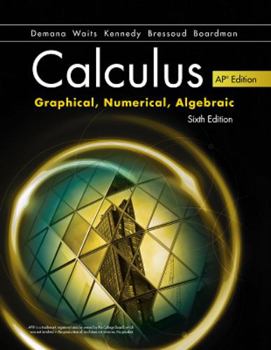Advanced Placement Calculus Graphical Numerical Algebraic Sixth Edition High School Binding Copyright 2020
Select Format
Select Condition 
Book Overview
For AP(R) Calculus AB and BC
This course is available on MyMathLab for School.
The sixth edition of Calculus: Graphical, Numerical, Algebraic, AP* Edition, by Demana,
Waits, Kennedy, Bressoud, and Boardman completely supports the content, philosophy,
and goals of the Advanced Placement (AP*) Calculus courses (AB and BC).
The College Board recently finished a lengthy and thorough review of the AP* Calculus
courses to ensure that they were consistent with the best college and university courses
with similar educational goals. This review resulted in a repackaging of the course descriptions
in terms of big ideas, enduring understandings, learning objectives, and essential
knowledge, but the learning goals remained essentially the same. That allowed us to retain
the overall flow of our previous edition and concentrate our attention on how we might be
more helpful to you and your students in certain parts of the course.
A very broad look at the overall goals of this text is given in the following bulleted summary.
Although these are not explicit goals of the AP program and do not include all of the
learning objectives in the new AP Curriculum Framework, they do reflect the intentions of
the AP Calculus program. (Note that the goals preceded by an asterisk are aligned with the BC course and are not required in AB Calculus.)
- Students will be able to work with functions represented graphically, numerically, analytically,
or verbally and will understand the connections among these representations;
graphing calculators will be used as a tool to facilitate such understanding.
- Students will, in the process of solving problems, be able to use graphing calculators to
graph functions, solve equations, evaluate numerical derivatives, and evaluate numerical
integrals.
- Students will understand the meaning of the derivative as a limit of a difference quotient
and will understand its connection to local linearity and instantaneous rates of change.
- Students will understand the meaning of the definite integral as a limit of Riemann
sums and as a net accumulation of change over an interval, and they will understand and
appreciate the connection between derivatives and integrals.
- Students will be able to model real-world behavior and solve a variety of problems
using functions, derivatives, and integrals; they will also be able to communicate solutions
effectively, using proper mathematical language and syntax.
- Students will be able to represent and interpret differential equations geometrically with
slope fields and (*) numerically with Euler's method; they will be able to model dynamic
situations with differential equations and solve initial value problems analytically.
(*) Students will understand the convergence and divergence of infinite series and will
be able to represent functions with Maclaurin and Taylor series; they will be able to
approximate or bound truncation errors in various ways.
(*) Students will be able to extend some calculus results to the context of motion in the
plane (through vectors) and to the analysis of polar curves.
Changes to This Edition:
The big change in this new edition, of course, is that we welcome Michael Boardman to the author team. As a college mathematician with years of experience with the Advanced Placement (AP) program, he is well acquainted with the scope and goals of the course, and he is well versed in the mathematics that calculus students should know. Not only was Michael chief reader of the AP Calculus exams for four years, but he also served five years on the Development Committee and five years on the AP Calculus Workgroup for ETS. As perhaps his signal achievement, he founded the online discussion group for AP Calculus teachers and moderated it for a decade, so he truly understands what AP teachers
and students are looking for in these pages.
A Few Global Changes
As with previous editions, we have kept our focus on high school students taking one of the College Board's AP courses, Calculus AB or Calculus BC. The topics in the text reflect both the curriculum and the pedagogy of an AP course, and we do what we can to prepare students for the AP examinations throughout the text. To be consistent with the AP exam, we have changed all multiple-choice questions in the exercises to show four options rather than five. Also, as free-response questions on the AP examinations continue to evolve in focus and style, we have added or amended our exercises to reflect those changes. Although the role of graphing calculators in the course has not changed significantly since the fifth edition, we continue to review the gray "no calculator" ovals in the exercise sets to reflect an emerging consensus among calculus teachers that not every problem that can be solved without a calculator ought to be solved without a calculator.
We have further expanded the treatment of the derivative as a measure of sensitivity, which now appears as an ongoing topic in several different sections of the text. We have also enhanced our commitment to point-slope form for linear equations throughout the text, writing them all in a form that emphasizes the concept of local linearity, critical for understanding differential calculus.
Two new features have been added in response to the MPACs. There are now Notational Fluency Notes sprinkled throughout the text, and each set of Chapter Review Exercises begins with Reasoning with Definitions and Theorems questions that require students (individually or with their classmates) to dig more deeply into the concepts of calculus in order to understand them better.
Most of the motivational "Chapter Opener" problems are new and improved in this edition, and (thanks





